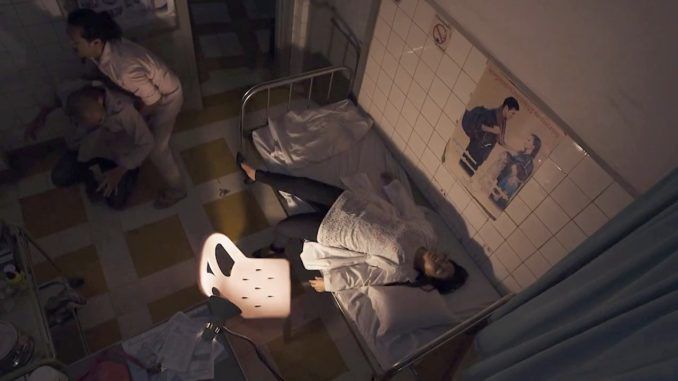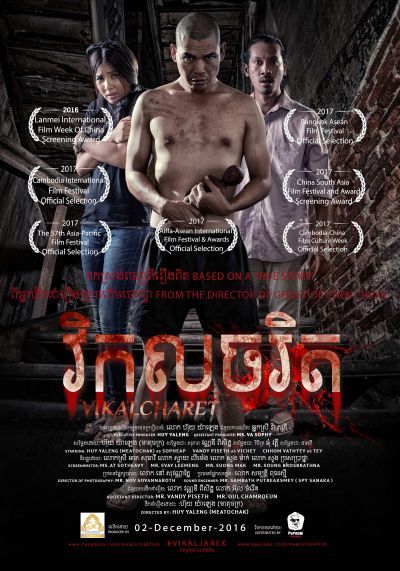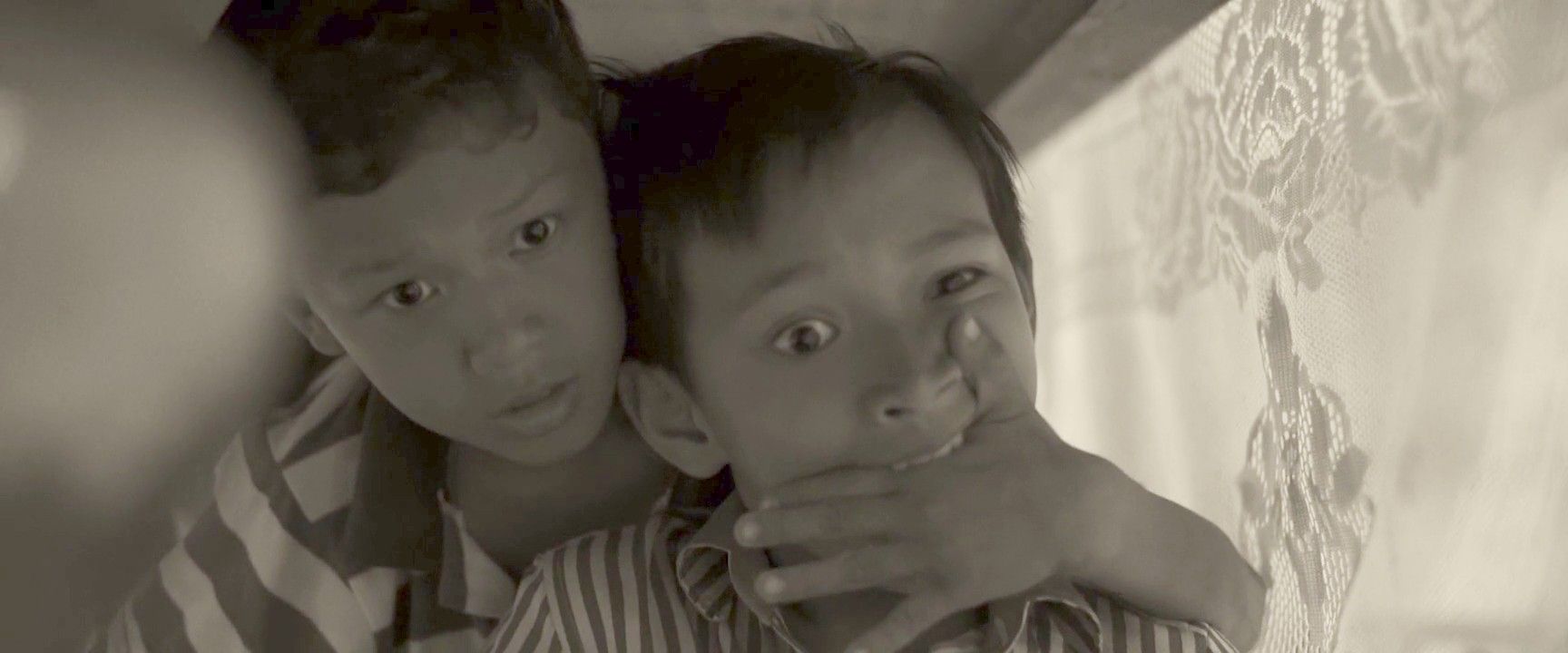
Rating: B-
Dir: Huy Yaleng
Star: Vandy Piseth, Huy Yaleng, Chhorn Vahtey, Nary Chum
So, our next stop takes us to Cambodia. I’m not going to lie, I was wondering how I could possibly come up with a thousand words on this film and the history of horror movies in Cambodia. I was thinking there would have been a lot of Dead Kennedys references. It turns out that, if you dig, the country has a longer and stronger tradition than some of the countries previously covered. By “if you dig,” I mean that the first entry when you Google “Cambodian horror” is the Wikipedia article on the genocide under Pol Pot. Having read it… yeah, I’m not going to argue with the Google search result. Security Prison 21 deserves a film as much as Unit 731.
We are not here for real life horror. Cambodian-set horror dates back as far as the thirties, with Revolt of the Zombies, from the director of White Zombie, which included footage filmed at the world-renowned temple of Angkor War. However, to find the first local production we need to wait until 1970 and The Snake King’s Wife, directed by Tea Lim Koun. This was a roaring success in the Cambodian market, and kicked off a slew of similar movies for the first half of the decade, with titles like Crocodile Man and The Snake Girl. With the fall of the capital Phnom Penh to the Khmer Rouge in 1975, film production ceased, and for the horror genre, recovery took more than a quarter century.
 It was spurred by an unusual incident, after a newspaper falsely claimed in 2003 that a Thai actress had said Angkor Wat belonged to Thailand. This led to riots, the burning of the Thai embassy and the banning of TV shows and films from the country, that at the time formed a large portion of the market in Cambodia. This opened the door to local producers, who stepped in to fill the gap. Horror was a big component. One estimate says in the years which followed, half of all Cambodian movies were in the genre, made by companies like FCI Production and Campro Production. These were quick and cheap, a contemporary report says, “Making a movie takes Campro about three months and costs an average of US$30,000, including about US$1,000 for the lead actor.”
It was spurred by an unusual incident, after a newspaper falsely claimed in 2003 that a Thai actress had said Angkor Wat belonged to Thailand. This led to riots, the burning of the Thai embassy and the banning of TV shows and films from the country, that at the time formed a large portion of the market in Cambodia. This opened the door to local producers, who stepped in to fill the gap. Horror was a big component. One estimate says in the years which followed, half of all Cambodian movies were in the genre, made by companies like FCI Production and Campro Production. These were quick and cheap, a contemporary report says, “Making a movie takes Campro about three months and costs an average of US$30,000, including about US$1,000 for the lead actor.”
There’s a heavy influence of J-horror on a lot of these, mixed in with stories from local folklore. For example, the “ap”, the disembodied head of a young woman, which flies about in the night, its entrails trailing behind it [a similar figure appear in other countries’ legends, such as the Philippines]. Inspiration has also been taken from Western horror, such as 2007’s slasher pic, The Waterfall of Death. However, most of these have been entirely for local consumption, and few make it outside the country. Some, such as 2023’s The Dark Mother are released in other South-East Asian countries. Getting one in the West, and with English subtitles, is another matter.
It was basically this or Nieng Arp, about the ap discussed above. It dates from 2004, so falls outside the time-frame of this series. To be honest, that it also runs two hours and thirty minutes, and looks very cheap, factored into this decision. I’ll probably get round to a write-up… eventually, and I think tabling it proved a wise choice. While a little rough around the edges, especially in regard to belabouring some of its concepts, Vikalcharet ends up having some significant positives, when it gets there. It begins with the boilerplate “inspired by true events” claim, though may have more to support it than normal. A prologue tells us it was apparently inspired by a neighbour of the director, who was driven mad through trauma.
We then meet the young men who are our two leads: Sopheap, played by the director, and Vichet (Piseth). They have been best friends since they were kids. Vichet was an orphan, and basically brought up by Sopheap’s parents, a debt he now repays by taking care of their son. For the problem is, Sopheap is severely mentally unstable, persistently troubled by nightmarish visions of blood-spattered ghosts and other spirits, making it difficult for him to hold down an everyday job. Workmates just don’t understand: in their defense, particularly problematic is how Sopheap reacts to the ghosts by lashing out in sudden violence. As we see when he impales his construction site supervisor with an iron rod. Time for him and Vichet to move on to another position.
 Vichet meets and falls for local girl Tey (Vahtey), and begins to realize that his commitment to Sopheap is going to interfere with their romantic relationship. Not least after Sopheap kills a doctor (Chum) who has been trying to help him. We also discover the source of the trauma which broke him. He watched as an intruder brutally killed both of his parents at home, an incident (above) which left Sopheap traumatized. But is this the whole story? My use of the question-mark likely gives the game away, for the truth eventually emerges, in a finale which I found surprisingly poignant. The film then closes with a caption pleading for better treatment of the mentally ill. The empathy displayed is only slightly weakened by it calling them “psychotics.”
Vichet meets and falls for local girl Tey (Vahtey), and begins to realize that his commitment to Sopheap is going to interfere with their romantic relationship. Not least after Sopheap kills a doctor (Chum) who has been trying to help him. We also discover the source of the trauma which broke him. He watched as an intruder brutally killed both of his parents at home, an incident (above) which left Sopheap traumatized. But is this the whole story? My use of the question-mark likely gives the game away, for the truth eventually emerges, in a finale which I found surprisingly poignant. The film then closes with a caption pleading for better treatment of the mentally ill. The empathy displayed is only slightly weakened by it calling them “psychotics.”
The first half does feel like overkill. The movie quickly establishes what being inside Sopheap’s head is like, but Yaleng then spends too much time engaged in moderate variations on the same theme, to diminishing effect. These rely heavily on jump scares, typically accompanied by loud audio cues, and are neither subtle nor effective. It’s a shame, because once he gets past that and settles down, working on the other plot elements discussed above, it’s effective and thought-provoking. Notions such as filial responsibility, and the very nature of insanity, are addressed with some skill. Particular credit to Piseth, for delivering a good performance, whose strength is perhaps only apparent after the end credits.
This review is part of our October 2024 feature, 31 More Countries of Horror.
